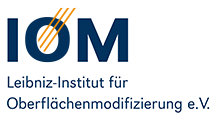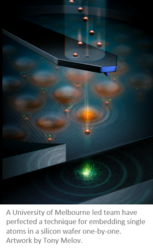Deterministic ion implantation is a key technology for fabricating ordered arrays of single atoms in solids. Functionalized as qubits they form a basis for a quantum computer. For this purpose, a spatially highly resolved ion implantation must be combined with a suitable method for detecting each implanted ion individually.
Currently there are several approaches to deterministic ion implantation under development worldwide. Whereas at the IOM in the cross-section unit “Tools” an approach based on image charge detection is under development for the ion detection, the long-time research collaborators at the University of Melbourne employ the free charge carriers produced in the silicon substrate during the ion implantation itself. In order to do so, the silicon substrate needs to act as a particle detector. Through significant improvements of the fabrication processes involved and the development of very low-noise detector electronics, the Australian colleagues were successful in improving the efficiency of ion detection to almost 100%. This allows error-free fabrication of ordered arrays of many individual atoms, laying a basis for the quantum computers of the future.
The study was performed at the University of Melbourne with contributions from UNSW Sydney, the Helmholtz-Zentrum Dresden-Rossendorf, the Leibniz Institute of Surface Engineering (IOM) and the RMIT Microscopy and Microanalysis Facility. The contribution of the IOM was establishing the theoretical foundations for calculating the detection efficiency by the scientist Dr. Daniel Spemann in collaboration with Dr. Alexander Jakob from the University of Melbourne. The results of this collaborative work have now been published in the renowned journal Advanced Materials. Further information can be found in the publication:
Deterministic Shallow Dopant Implantation in Silicon with Detection Confidence Upper-Bound to 99.85% by Ion–Solid Interactions
Alexander M. Jakob, Simon G. Robson, Vivien Schmitt, Vincent Mourik, Matthias Posselt, Daniel Spemann, Brett C. Johnson, Hannes R. Firgau, Edwin Mayes, Jeffrey C. McCallum, Andrea Morello, David N. Jamieson
Adv. Mater. 34 (2022) 2103235
https://doi.org/10.1002/adma.202103235
Link to the press release: “Building a silicon quantum computer chip atom by atom”

